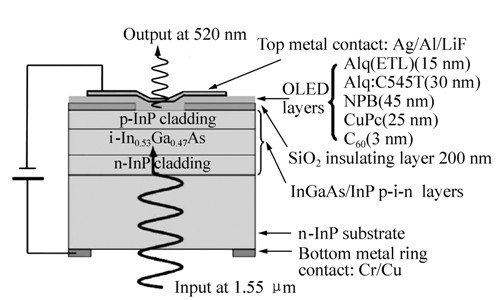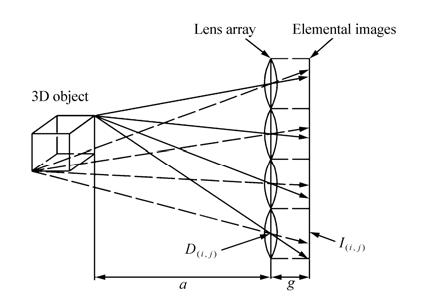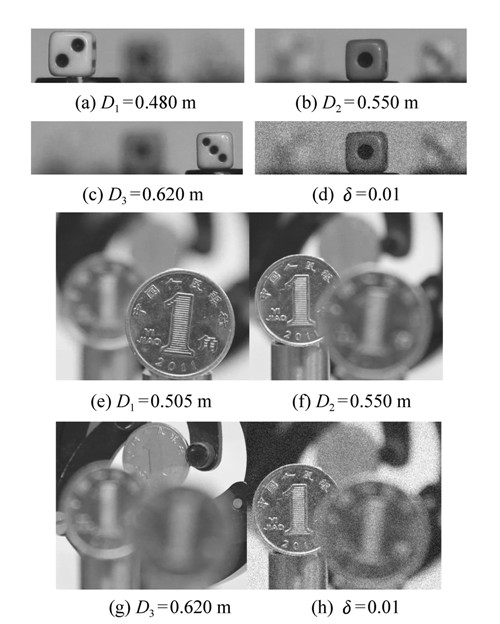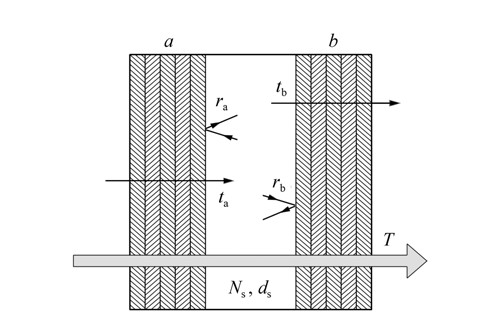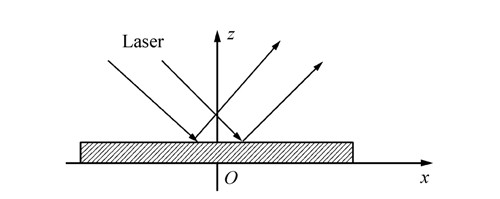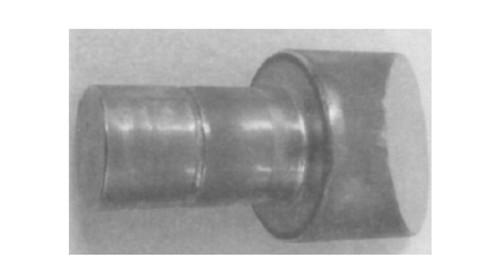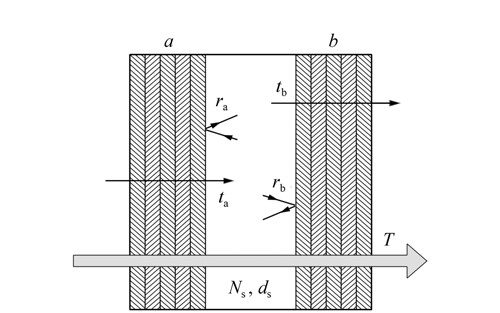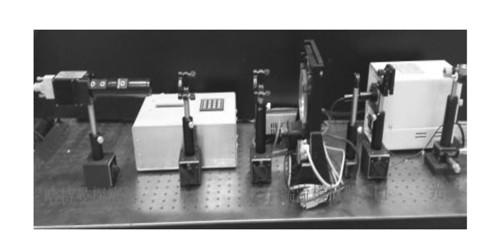2015 Vol. 8, No. 1
2015, 8(1): 1-16.
doi: 10.3788/CO.20150801.0001
Abstract:
Changchun Institute of Optics, Fine Mechanics and Physics(CIOMP), Chinese Academy of Sciences(CAS) has made great efforts for over two decades on promoting herself to be a very important base of space remote sensing equipments' developing in China. The current status of CIOMP in this field is introduced in this paper based on the review of its development history, including the design, manufacturing, alignment, detection, and test of space remote sensing equipments, etc.
Changchun Institute of Optics, Fine Mechanics and Physics(CIOMP), Chinese Academy of Sciences(CAS) has made great efforts for over two decades on promoting herself to be a very important base of space remote sensing equipments' developing in China. The current status of CIOMP in this field is introduced in this paper based on the review of its development history, including the design, manufacturing, alignment, detection, and test of space remote sensing equipments, etc.
2015, 8(1): 17-27.
doi: 10.3788/CO.20150801.0017
Abstract:
This paper presents recent research and development effort in realizing and perfecting the infrared upconversion device, and mainly focuses on the design optimization, device integration and internal semiconductor physics of different optical up-conversion device structures. The upconversion idea relies on the integration of a photodetector and an organic light-emitting device(OLED). The infrared is first absorbed by photodetector part, and then the photocurrent would drive the OLED to emit visible light, which functions as infrared-to-visible upconversion. This research enhanced the application of OLED in infrared imaging.
This paper presents recent research and development effort in realizing and perfecting the infrared upconversion device, and mainly focuses on the design optimization, device integration and internal semiconductor physics of different optical up-conversion device structures. The upconversion idea relies on the integration of a photodetector and an organic light-emitting device(OLED). The infrared is first absorbed by photodetector part, and then the photocurrent would drive the OLED to emit visible light, which functions as infrared-to-visible upconversion. This research enhanced the application of OLED in infrared imaging.
2015, 8(1): 28-38.
doi: 10.3788/CO.20150801.0028
Abstract:
Laser active imaging system has been used in many fields due to its high precision of angular, range and velocity, so laser active imaging system with direct ranging are researched deeply. According to the operational mode, principle and systemic parameter of many laser active imaging systems from several overseas research institutes are introduced. The advantages and shortcomings of those operational modes are summarized and compared. Analyzing result shows that long operational range could be gained with single or small FPA combining optical-mechanical scanning. But the repeated- frequency of laser would be high and post data-processing is complicated with this method. The volume and power dissipation is also considerable. Compact laser active imaging system could be achieved easily with flash sensor and related repeated-frequency of laser is low. Although operational range is limited, it could be enhanced by using electronical steering method. In actural system, several factors, such as volume, weight and power dissipation of system, peak power and repeated frequency of laser, type of sensor and post data-processing capability, should be taken into account comprehensively to reach a comprise.
Laser active imaging system has been used in many fields due to its high precision of angular, range and velocity, so laser active imaging system with direct ranging are researched deeply. According to the operational mode, principle and systemic parameter of many laser active imaging systems from several overseas research institutes are introduced. The advantages and shortcomings of those operational modes are summarized and compared. Analyzing result shows that long operational range could be gained with single or small FPA combining optical-mechanical scanning. But the repeated- frequency of laser would be high and post data-processing is complicated with this method. The volume and power dissipation is also considerable. Compact laser active imaging system could be achieved easily with flash sensor and related repeated-frequency of laser is low. Although operational range is limited, it could be enhanced by using electronical steering method. In actural system, several factors, such as volume, weight and power dissipation of system, peak power and repeated frequency of laser, type of sensor and post data-processing capability, should be taken into account comprehensively to reach a comprise.
2015, 8(1): 39-44.
doi: 10.3788/CO.20150801.0039
Abstract:
Precisely detecting phase noise in the optical fiber is one of the core techniques for high resolution microwave dissemination based on optical fiber link. In order to solve the problem that unwanted reflections from fiber interconnectors greatly reduce the accuracy of phase noise detection, we propose and demonstrate a spectrally shifted optical feedback scheme integrated with wavelength division multiplexing technique for precise phase detection based on nonlinear propagation of narrow band optical frequency comb in dispersion shifted fiber. Theoretical and preliminary experimental results show that the proposed approach efficiently suppresses the reflection noise.
Precisely detecting phase noise in the optical fiber is one of the core techniques for high resolution microwave dissemination based on optical fiber link. In order to solve the problem that unwanted reflections from fiber interconnectors greatly reduce the accuracy of phase noise detection, we propose and demonstrate a spectrally shifted optical feedback scheme integrated with wavelength division multiplexing technique for precise phase detection based on nonlinear propagation of narrow band optical frequency comb in dispersion shifted fiber. Theoretical and preliminary experimental results show that the proposed approach efficiently suppresses the reflection noise.
2015, 8(1): 45-50.
doi: 10.3788/CO.20150801.0045
Abstract:
In order to realize the passive three-dimensional(3D) shape acquisition technology, the ray tracing is used to analyze the processing of pick-up information by the integral imaging system, and the relationship in the corresponding points is shown under the theoretical analysis. Then, the 3D shape acquisition technology by integral imaging based on the relationship of the corresponding points is proposed. The optical results show that the coordinates of points in the object space can be captured by the proposed technology. The 3D shape can be reconstructed from the corresponding points. The coordinates of the object point can be calculated. The relative error is smaller than 5%. The result confirms the feasibility of our proposed method to realize the acquisition for 3D optical information.
In order to realize the passive three-dimensional(3D) shape acquisition technology, the ray tracing is used to analyze the processing of pick-up information by the integral imaging system, and the relationship in the corresponding points is shown under the theoretical analysis. Then, the 3D shape acquisition technology by integral imaging based on the relationship of the corresponding points is proposed. The optical results show that the coordinates of points in the object space can be captured by the proposed technology. The 3D shape can be reconstructed from the corresponding points. The coordinates of the object point can be calculated. The relative error is smaller than 5%. The result confirms the feasibility of our proposed method to realize the acquisition for 3D optical information.
2015, 8(1): 51-59.
doi: 10.3788/CO.20150801.0051
Abstract:
With factors such as the nonuniform response of infrared detector units, stripe nonuniformity in images is observed. To solve this problem, a novel correction method to use histogram weighting and Savitzky-Golay filter fitting(HWSG) together is developed. Firstly, the normalized histogram functions of each column are calculated and taken as weights of the stripe image. Secondly, the Savitzky-Golay filter is used to fit the weighted column mean values and variances. The fitting result is put into the correction formula, and then the corrected image is obtained after adjustable parameter iterations. The experimental results demonstrate that the proposed approach is efficient and retains the image spectrum and texture information excellently. A 10% improvement of each evaluation index has been achieved.
With factors such as the nonuniform response of infrared detector units, stripe nonuniformity in images is observed. To solve this problem, a novel correction method to use histogram weighting and Savitzky-Golay filter fitting(HWSG) together is developed. Firstly, the normalized histogram functions of each column are calculated and taken as weights of the stripe image. Secondly, the Savitzky-Golay filter is used to fit the weighted column mean values and variances. The fitting result is put into the correction formula, and then the corrected image is obtained after adjustable parameter iterations. The experimental results demonstrate that the proposed approach is efficient and retains the image spectrum and texture information excellently. A 10% improvement of each evaluation index has been achieved.
2015, 8(1): 60-67.
doi: 10.3788/CO.20150801.0060
Abstract:
In digital holography, multi-focus holographic images can be reconstructed by applying values for the reconstruction distance during the reconstruction process. And then the hologram can be fused to extend the depth-of-field by images fusion method. Since the speckle noise in the digital holography images, an efficient fusion algorithm based on mathematical morphology is proposed. First, the decomposed high-frequency and low-frequency sub-band coefficients are obtained by the Wavelet-Controulet transform. Then, it fused coefficients with different rules. To suppress the speckle noise, the local energy combined with mathematical morphology is presented for high-frequency coefficients and the contrast method is used to fuse the low-frequency coefficients. Finally, the invers transform is employed to get the fused image. The effectiveness analysis of the algorithm and the experiment results show that for the digital holography images with speckle noise, the fusion method with mathematical morphology can reduce the speckle noise and keep more detail information. At last, the depth-field of the image can be extended up to 11.5 cm. As compared with the conventional method without mathematical morphology, for dices, the proposed method enhances its Tenengrad and Entropy by 11.8% and 2.7%. For coins, the proposed method enhances its Tenengrad and Entropy by 13.6% and 2.8%.
In digital holography, multi-focus holographic images can be reconstructed by applying values for the reconstruction distance during the reconstruction process. And then the hologram can be fused to extend the depth-of-field by images fusion method. Since the speckle noise in the digital holography images, an efficient fusion algorithm based on mathematical morphology is proposed. First, the decomposed high-frequency and low-frequency sub-band coefficients are obtained by the Wavelet-Controulet transform. Then, it fused coefficients with different rules. To suppress the speckle noise, the local energy combined with mathematical morphology is presented for high-frequency coefficients and the contrast method is used to fuse the low-frequency coefficients. Finally, the invers transform is employed to get the fused image. The effectiveness analysis of the algorithm and the experiment results show that for the digital holography images with speckle noise, the fusion method with mathematical morphology can reduce the speckle noise and keep more detail information. At last, the depth-field of the image can be extended up to 11.5 cm. As compared with the conventional method without mathematical morphology, for dices, the proposed method enhances its Tenengrad and Entropy by 11.8% and 2.7%. For coins, the proposed method enhances its Tenengrad and Entropy by 13.6% and 2.8%.
2015, 8(1): 68-73.
doi: 10.3788/CO.20150801.0068
Abstract:
In order to improve the image segmentation speed when using C-V model, reduce the segmentation coupling with initial contour position, and improve the image segmentation efficiency of multi-spectral imager, an improved C-V model is proposed in the paper. In this model, the Dirac function' parameter is corrected adaptively by introducing the maximum value of distance function in each iteration. In this way, the effective range of active contour is broadened, and the number of iterations is reduced. The experimental results show that the ideal segmentation effect is obtained by the improved C-V model with the iteration termination condition. Compared with the classic C-V model, the influence of initial contour position on segmentation is reduced. In addition, the convergence speed is improved by 7 times. The characteristics of real time and global nature both become better. Therefore, the robustness of multi-spectral imager segmentation is improved accordingly.
In order to improve the image segmentation speed when using C-V model, reduce the segmentation coupling with initial contour position, and improve the image segmentation efficiency of multi-spectral imager, an improved C-V model is proposed in the paper. In this model, the Dirac function' parameter is corrected adaptively by introducing the maximum value of distance function in each iteration. In this way, the effective range of active contour is broadened, and the number of iterations is reduced. The experimental results show that the ideal segmentation effect is obtained by the improved C-V model with the iteration termination condition. Compared with the classic C-V model, the influence of initial contour position on segmentation is reduced. In addition, the convergence speed is improved by 7 times. The characteristics of real time and global nature both become better. Therefore, the robustness of multi-spectral imager segmentation is improved accordingly.
2015, 8(1): 74-83.
doi: 10.3788/CO.20150801.0074
Abstract:
For the laser etalon with solid dielectric spacer-layer, the effects of the stack numbers of reflection films on the reflection bandwidth, the thickness of substrate and the free spectral range are first studied by taking an example of laser etalon working at 1 064 nm. The results indicate that the bandwidth of the etalon decreases with the stack number increasing, and the free spectral range decreases with the thickness of substrate increasing. Then the effects of the deviation of substrate on the central wavelength and the transmittance of etalon are studied. The deviation of substrate thickness could be compensated by adjusting the working angle of the etalon through the numerical calculation. Further more, for the two typical coating structures such as H(LH)m/Substrate/(HL)m H and L(LH)m/Substrate/(HL)mL, the effects of the divergence angle of incident laser on the central wavelength, the half pass band width, the transmittance at central wavelength and the maximum transmittance are investigated. The results demonstrate that with the increasing of divergence angle, the central wavelength shifts to the shorter wavelength, and the half pass band width, the transmittance at central wavelength and the maximum transmittance show a downward tend. The performance of etalon with the coating structure of L(LH)m/substrate/(HL)mL is superior to that of H(LH)m/substrate/(HL)mH.
For the laser etalon with solid dielectric spacer-layer, the effects of the stack numbers of reflection films on the reflection bandwidth, the thickness of substrate and the free spectral range are first studied by taking an example of laser etalon working at 1 064 nm. The results indicate that the bandwidth of the etalon decreases with the stack number increasing, and the free spectral range decreases with the thickness of substrate increasing. Then the effects of the deviation of substrate on the central wavelength and the transmittance of etalon are studied. The deviation of substrate thickness could be compensated by adjusting the working angle of the etalon through the numerical calculation. Further more, for the two typical coating structures such as H(LH)m/Substrate/(HL)m H and L(LH)m/Substrate/(HL)mL, the effects of the divergence angle of incident laser on the central wavelength, the half pass band width, the transmittance at central wavelength and the maximum transmittance are investigated. The results demonstrate that with the increasing of divergence angle, the central wavelength shifts to the shorter wavelength, and the half pass band width, the transmittance at central wavelength and the maximum transmittance show a downward tend. The performance of etalon with the coating structure of L(LH)m/substrate/(HL)mL is superior to that of H(LH)m/substrate/(HL)mH.
2015, 8(1): 84-90.
doi: 10.3788/CO.20150801.0084
Abstract:
In order to analyze the effect of thermal deformation of the mirror irradiated by laser beam on the beam quality, thermal-static structural coupled model of high absorption chrome plated mirror irradiated by laser beam with the incidence angle of 45° is built. Thermal deformation under different irradiation laser and the influence of mirror thickness on the deformation are analyzed. Then thermal deformation is detected with Hartmann wavefront sensor on free boundary condition. The results show that thermal deformation increases approximately linearly with the increase of the power absorbed at the range of 0.085-0.185 W. When the diameter of the facula increases, the deformation decreases. When mirror's thickness keeps in the range of 1~5 mm, the deformation merely keeps constant. In the initial stage of laser irradiation, the temperature and deformation increase rapidly. After 20 s, the increase of temperature on the mirror becomes slowly. The deformation increases to 0.27 μm in 1 s, and then increase slowly. The deformation will reach balance after 100 s. When the irradiation laser is removed, the mirror will return to the initial state after 120 s. The analysis result shows that the testing error is mainly caused by the error of the diameter of the facula and the incident angle of the laser.
In order to analyze the effect of thermal deformation of the mirror irradiated by laser beam on the beam quality, thermal-static structural coupled model of high absorption chrome plated mirror irradiated by laser beam with the incidence angle of 45° is built. Thermal deformation under different irradiation laser and the influence of mirror thickness on the deformation are analyzed. Then thermal deformation is detected with Hartmann wavefront sensor on free boundary condition. The results show that thermal deformation increases approximately linearly with the increase of the power absorbed at the range of 0.085-0.185 W. When the diameter of the facula increases, the deformation decreases. When mirror's thickness keeps in the range of 1~5 mm, the deformation merely keeps constant. In the initial stage of laser irradiation, the temperature and deformation increase rapidly. After 20 s, the increase of temperature on the mirror becomes slowly. The deformation increases to 0.27 μm in 1 s, and then increase slowly. The deformation will reach balance after 100 s. When the irradiation laser is removed, the mirror will return to the initial state after 120 s. The analysis result shows that the testing error is mainly caused by the error of the diameter of the facula and the incident angle of the laser.
2015, 8(1): 91-98.
doi: 10.3788/CO.20150801.0091
Abstract:
Developing smart luminescent materials is desirable for different fluorescence imaging applications. Here, we report a new luminescent material called luminescent "nano-bombs" based on supra-carbon-nanodots, whose luminescence depends strongly on water contact. That kind of "nano-bombs" show weak emission in toluene and decompose when meeting water, resulting in strong photoluminescence. With these "nano-bombs" we demonstrate water-jet printing luminescence patterns and mapping human sweat pore patterns in the supra-carbon-nanodots-coated paper. While by now most of smart luminescent materials suffer, more or less, low photostability, potential biotoxicity, high cost or poor compatibility with traditional inkjet printing technology, such a carbon-based nanomaterial without(or with much less) those deficiencies may find practical applications in optical information storage, forensic and healthcare.
Developing smart luminescent materials is desirable for different fluorescence imaging applications. Here, we report a new luminescent material called luminescent "nano-bombs" based on supra-carbon-nanodots, whose luminescence depends strongly on water contact. That kind of "nano-bombs" show weak emission in toluene and decompose when meeting water, resulting in strong photoluminescence. With these "nano-bombs" we demonstrate water-jet printing luminescence patterns and mapping human sweat pore patterns in the supra-carbon-nanodots-coated paper. While by now most of smart luminescent materials suffer, more or less, low photostability, potential biotoxicity, high cost or poor compatibility with traditional inkjet printing technology, such a carbon-based nanomaterial without(or with much less) those deficiencies may find practical applications in optical information storage, forensic and healthcare.
2015, 8(1): 99-106.
doi: 10.3788/CO.20150801.0099
Abstract:
The difference of linear expansion coefficient between a mirror and its support structure causes mirror thermal deformation which influences the surface accuracy of mirror and the image quality of optical system. In order to avoid above influence, the high volume fraction SiC/Al composite is chosen as the only material of a Φ600 mm mirror component. The Φ600 mm mirror structure parameters are specified by the reasonable mechanical design and finite element analysis. Using finite element analysis method, the static and dynamic characteristics of the mirror component are analyzed. Under the gravity load of 1 g, the surface figure accuracy of the high volume fraction SiC/Al composite mirror reaches RMS 12.6 nm, 12.7 nm, 12.6 nm, in X, Y, Z respective direction, nearly λ/50(λ=632.8 nm). The mechanical dynamic test results verify the structural performance and the capability of vibration resistance. The 1st order natural frequency of the mirror component is 556.6 Hz. After the test, the surface figure accuracy changs from RMS 0.021λ to 0.025λ, not showing obvious changes. The high volume fraction SiC/Al mirror can reach the same design indexes as SiC mirror and meet the space application requirements.
The difference of linear expansion coefficient between a mirror and its support structure causes mirror thermal deformation which influences the surface accuracy of mirror and the image quality of optical system. In order to avoid above influence, the high volume fraction SiC/Al composite is chosen as the only material of a Φ600 mm mirror component. The Φ600 mm mirror structure parameters are specified by the reasonable mechanical design and finite element analysis. Using finite element analysis method, the static and dynamic characteristics of the mirror component are analyzed. Under the gravity load of 1 g, the surface figure accuracy of the high volume fraction SiC/Al composite mirror reaches RMS 12.6 nm, 12.7 nm, 12.6 nm, in X, Y, Z respective direction, nearly λ/50(λ=632.8 nm). The mechanical dynamic test results verify the structural performance and the capability of vibration resistance. The 1st order natural frequency of the mirror component is 556.6 Hz. After the test, the surface figure accuracy changs from RMS 0.021λ to 0.025λ, not showing obvious changes. The high volume fraction SiC/Al mirror can reach the same design indexes as SiC mirror and meet the space application requirements.
2015, 8(1): 107-113.
doi: 10.3788/CO.20150801.0107
Abstract:
Using infrared scanning system principle, a novel long-wavelength continuous zoom scanning optical system is presented based on 4×288 infrared MCT detector dewar cooled assembly. Related optical index parameters are resolved and calculated according to requirements of system, and the optical design parameters and outside view are obtained by the optical design software. The narcissus effect of the scanning optical system are analyzed and optimized. The optical system is composed of zoom telescope, scanning mirror, relay lens, imaging lens and a tertiary imaging system including nine lenses and two reflectors. In order to reduce cost and optical color aberrations, chalcogenide glass lens is used. The optical index is simulated, and the MTF in whole field at Nyquist frequency is over 0.35 and distortion is below 2%.Finally the system imaging experimental verification is conducted. The results indicate that 30.8~154 mm continuous zoom and 100% cold shield efficiency are achieved. High resolution, thermal sensibility, excellent images are validated.
Using infrared scanning system principle, a novel long-wavelength continuous zoom scanning optical system is presented based on 4×288 infrared MCT detector dewar cooled assembly. Related optical index parameters are resolved and calculated according to requirements of system, and the optical design parameters and outside view are obtained by the optical design software. The narcissus effect of the scanning optical system are analyzed and optimized. The optical system is composed of zoom telescope, scanning mirror, relay lens, imaging lens and a tertiary imaging system including nine lenses and two reflectors. In order to reduce cost and optical color aberrations, chalcogenide glass lens is used. The optical index is simulated, and the MTF in whole field at Nyquist frequency is over 0.35 and distortion is below 2%.Finally the system imaging experimental verification is conducted. The results indicate that 30.8~154 mm continuous zoom and 100% cold shield efficiency are achieved. High resolution, thermal sensibility, excellent images are validated.
2015, 8(1): 114-120.
doi: 10.3788/CO.20150801.0114
Abstract:
In order to assist venipuncture and related medical operations, a novel vein imaging device based on head-mounted projective display(HMPD) is designed. The correspondent optical system consists of near-infrared imaging system and see-through HMPD. With the help of optical design software ZEMAX, the near-infrared imaging system has a large numerical aperture with F number of 2.6, which is extremely conducive to receive and to image the weak reflected near-infrared light. The structure of the optical system of HMPD is same as that of near-infrared imaging part, which is conducive to simplify the processing and assembly. The results indicate that the performance of imaging system is excellent and the resolution is up to QXGA(2 048×1 536). The see-through HMPD possesses an 18 mm exit pupil and a 25 mm eye relief, with the field curvature less than 0.03 D, the distortion less than 0.32% and the resolution up to QXGA. Compared with the current vein imaging device, the proposed system is characterized by compact structure, comfort wearing and ultrahigh resolution, which is suitable for assistant tools in venipuncture techniques.
In order to assist venipuncture and related medical operations, a novel vein imaging device based on head-mounted projective display(HMPD) is designed. The correspondent optical system consists of near-infrared imaging system and see-through HMPD. With the help of optical design software ZEMAX, the near-infrared imaging system has a large numerical aperture with F number of 2.6, which is extremely conducive to receive and to image the weak reflected near-infrared light. The structure of the optical system of HMPD is same as that of near-infrared imaging part, which is conducive to simplify the processing and assembly. The results indicate that the performance of imaging system is excellent and the resolution is up to QXGA(2 048×1 536). The see-through HMPD possesses an 18 mm exit pupil and a 25 mm eye relief, with the field curvature less than 0.03 D, the distortion less than 0.32% and the resolution up to QXGA. Compared with the current vein imaging device, the proposed system is characterized by compact structure, comfort wearing and ultrahigh resolution, which is suitable for assistant tools in venipuncture techniques.
2015, 8(1): 121-129.
doi: 10.3788/CO.20150801.0121
Abstract:
To measure the Greenwood frequency of the atmospheric turbulence accurately, the validity of phase difference method and the selection of the sampling points and the sampling frequency of the Shack-Hartmann wavefront sensor(S-H WFS) have been studied. Firstly, the principle of the phase difference method and the noise elimination algorithm are given. Secondly, the effects of the sampling points of S-H WFS and the statistical times of Greenwood frequency on the measurement accuracy are investigated. The experimental results show that, while both the sampling points and the statistical times are more than 400, the Greenwood frequency can be measured accurately. Thirdly, the influence of the measurement noise is considered and the result shows that the deviation error of the measured value is reduced from 30% to 0.6% with the noise removed. Fourthly, the repeatability of the phase difference method is measured. It is shown that the deviation RMS error is 1.9 Hz which is 3% of the ideal value. Therefore, the Greenwood frequency can be measured accurately with the phase difference method. Based on the above results, the Greenwood frequency of the atmospheric turbulence is measured and analyzed with the range of 8-108 Hz. It indicates that the measured value is almost the same as theoretical value without consideration of the disturbance of the air in the Lab. At last, the relation between the sampling frequency of S-H WFS and the Greenwood frequency is investigated. It can be seen that the sampling frequency of the S-H WFS should be increased if the measured Greenwood frequency is enlarged. Furthermore, an empirical formula is achieved to calculate the needed sampling frequency of the S-H WFS. In a word, all the results show that, when it meets the demand of sampling points, sampling frequency and statistical times, the phase difference method can be used to measure the Greenwood frequency of atmospheric turbulence accurately.
To measure the Greenwood frequency of the atmospheric turbulence accurately, the validity of phase difference method and the selection of the sampling points and the sampling frequency of the Shack-Hartmann wavefront sensor(S-H WFS) have been studied. Firstly, the principle of the phase difference method and the noise elimination algorithm are given. Secondly, the effects of the sampling points of S-H WFS and the statistical times of Greenwood frequency on the measurement accuracy are investigated. The experimental results show that, while both the sampling points and the statistical times are more than 400, the Greenwood frequency can be measured accurately. Thirdly, the influence of the measurement noise is considered and the result shows that the deviation error of the measured value is reduced from 30% to 0.6% with the noise removed. Fourthly, the repeatability of the phase difference method is measured. It is shown that the deviation RMS error is 1.9 Hz which is 3% of the ideal value. Therefore, the Greenwood frequency can be measured accurately with the phase difference method. Based on the above results, the Greenwood frequency of the atmospheric turbulence is measured and analyzed with the range of 8-108 Hz. It indicates that the measured value is almost the same as theoretical value without consideration of the disturbance of the air in the Lab. At last, the relation between the sampling frequency of S-H WFS and the Greenwood frequency is investigated. It can be seen that the sampling frequency of the S-H WFS should be increased if the measured Greenwood frequency is enlarged. Furthermore, an empirical formula is achieved to calculate the needed sampling frequency of the S-H WFS. In a word, all the results show that, when it meets the demand of sampling points, sampling frequency and statistical times, the phase difference method can be used to measure the Greenwood frequency of atmospheric turbulence accurately.
2015, 8(1): 130-138.
doi: 10.3788/CO.20150801.0130
Abstract:
In order to measure the value of projectile points on the water surface accurately, a model of dynamic images measurement based on CCD camera is established. The function of the value of the surface point and its measuring error are analyzed by using the collected images information of the relative points taken by CCD camera secondarily. First, with the knowledge of spatial geometry, the azimuth and the elevation angles of three designated points on the target ship relative to the measuring ship are obtained. Then, combined with image coordinates of the specified points at t point, the relationship function of two sets of parameters between the image plane coordinate and angle information is presented by taking the constant model, so the azimuth and the elevation angles information of the projectile point is obtained. The function of three-dimensional projectile burst coordinates is presented by non-coplane intersection method. Finally, the coordinate's errors from the evaluation of the pinpoint of the image and the location measurement accuracy are discussed and the relationship is investigated. Experimental results indicate that the three-dimensional projectile burst coordinate's measuring error are 2.8, 4.9, 4.3 m, respectively, in the condition of the minimum intersection error, when the position accuracy is up to 0.05 m and the image pinpoint accuracy to be able to 0.5 pixel.
In order to measure the value of projectile points on the water surface accurately, a model of dynamic images measurement based on CCD camera is established. The function of the value of the surface point and its measuring error are analyzed by using the collected images information of the relative points taken by CCD camera secondarily. First, with the knowledge of spatial geometry, the azimuth and the elevation angles of three designated points on the target ship relative to the measuring ship are obtained. Then, combined with image coordinates of the specified points at t point, the relationship function of two sets of parameters between the image plane coordinate and angle information is presented by taking the constant model, so the azimuth and the elevation angles information of the projectile point is obtained. The function of three-dimensional projectile burst coordinates is presented by non-coplane intersection method. Finally, the coordinate's errors from the evaluation of the pinpoint of the image and the location measurement accuracy are discussed and the relationship is investigated. Experimental results indicate that the three-dimensional projectile burst coordinate's measuring error are 2.8, 4.9, 4.3 m, respectively, in the condition of the minimum intersection error, when the position accuracy is up to 0.05 m and the image pinpoint accuracy to be able to 0.5 pixel.
2015, 8(1): 139-144.
doi: 10.3788/CO.20150801.0139
Abstract:
In recent years, the luminescence properties of the rare earth ions-doped nanocrystals become more and more popular because the rare earth luminescent nanocrystals have important applications in photoluminescence, high-definition display, optoelectronic nano-devices, biological labeling, laser and scintillator etc.. In this project, a series of different particle size, dispersion, controllable morphology rare earth ions-doped oxide(fluoride) micro-/nano-crystals were synthesized by soft chemistry synthesis method such as hydrothermal, sol-gel method et al.. The luminescence properties were investigated by excitation spectra, emission spectra, diffuse reflectance spectra and high-resolution laser spectra in order to observe the changes of luminescent phenomenon with different size and chemical bond. The essential reason of the impact of luminescence behavior was also investigated by summary and classification. At the same time, theoretical calculations of optical properties were performed by using density functional theory and complex crystal dielectric theory of chemical bond method with the combination of spectral experimental data, which can successfully explain the spectral shift rule and energy transfer mechanism between the different rare earth ions. The results can lay the theoretical and experimental basis for the other rare earth spectroscopy.
In recent years, the luminescence properties of the rare earth ions-doped nanocrystals become more and more popular because the rare earth luminescent nanocrystals have important applications in photoluminescence, high-definition display, optoelectronic nano-devices, biological labeling, laser and scintillator etc.. In this project, a series of different particle size, dispersion, controllable morphology rare earth ions-doped oxide(fluoride) micro-/nano-crystals were synthesized by soft chemistry synthesis method such as hydrothermal, sol-gel method et al.. The luminescence properties were investigated by excitation spectra, emission spectra, diffuse reflectance spectra and high-resolution laser spectra in order to observe the changes of luminescent phenomenon with different size and chemical bond. The essential reason of the impact of luminescence behavior was also investigated by summary and classification. At the same time, theoretical calculations of optical properties were performed by using density functional theory and complex crystal dielectric theory of chemical bond method with the combination of spectral experimental data, which can successfully explain the spectral shift rule and energy transfer mechanism between the different rare earth ions. The results can lay the theoretical and experimental basis for the other rare earth spectroscopy.


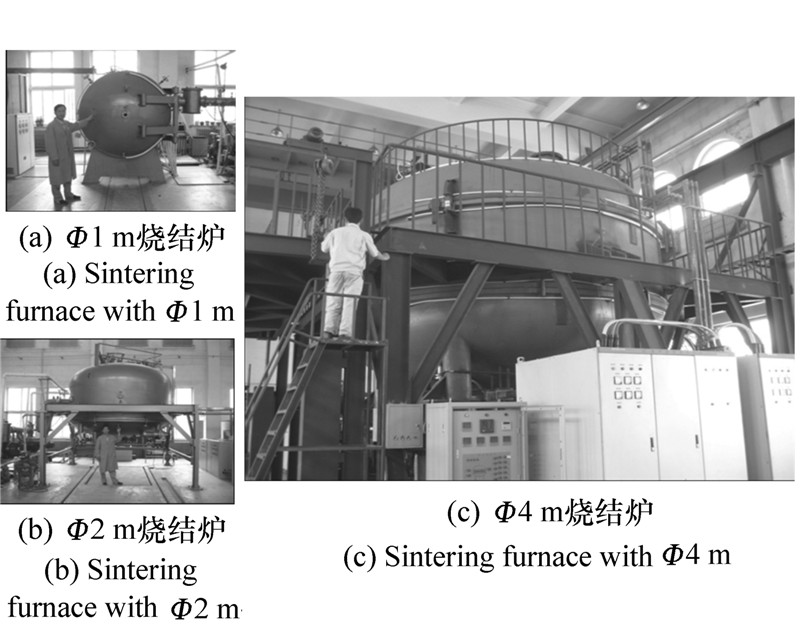
 Abstract
Abstract FullText HTML
FullText HTML PDF 3068KB
PDF 3068KB